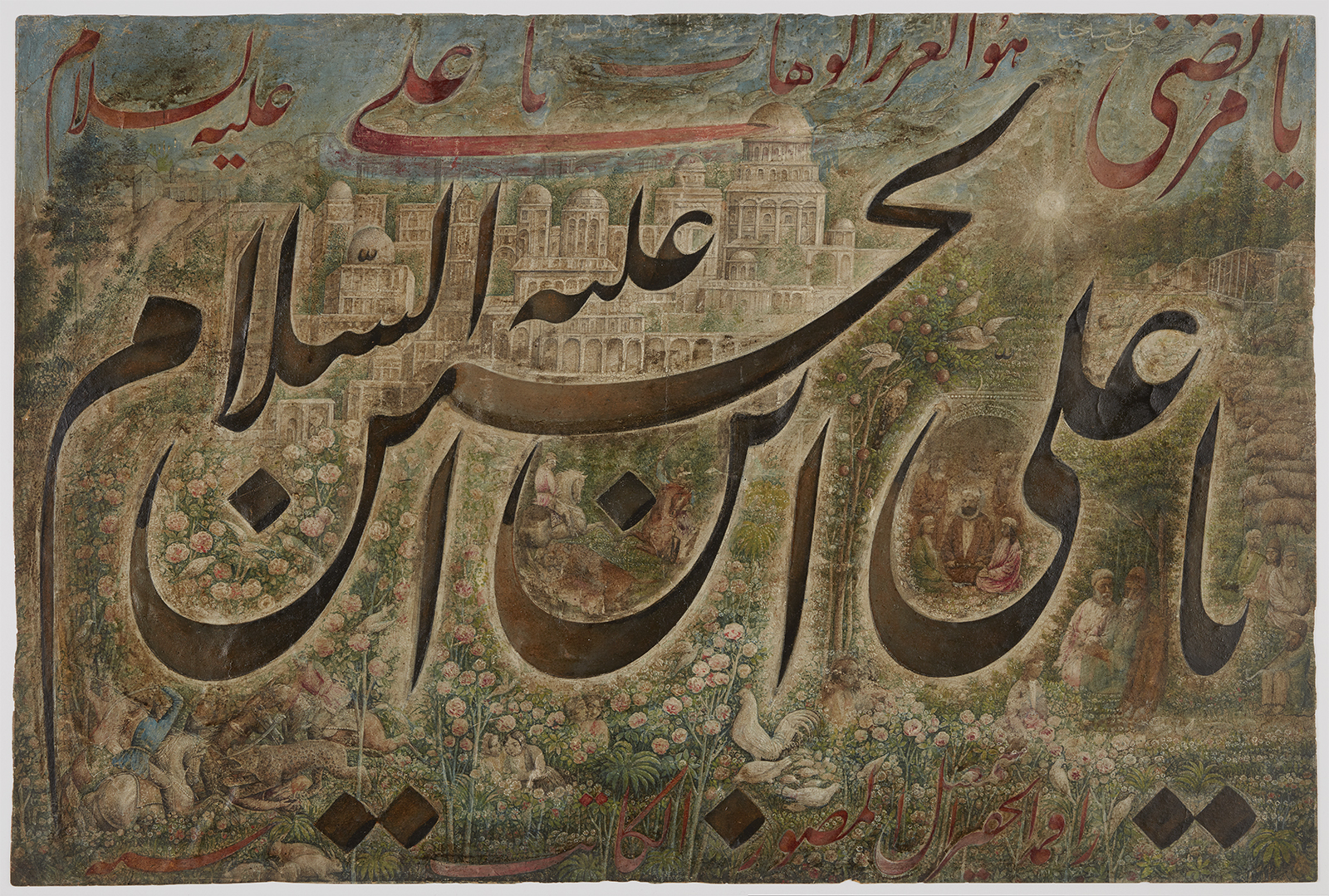Click on the image to zoom
Calligraphic Painting by Isma‘il Jalayir
Signed: Isma‘il Jalayir (raqamaha al-haqir Isma‘il al-musavvir al-katib sana …)
- Accession Number:AKM534
- Creator:Signed: Isma‘il Jalayir (raqamaha al-haqir Isma‘il al-musavvir al-katib sana …)
- Place:Iran
- Dimensions:35 x 53 cm
- Date:ca. 1860–70
- Materials and Technique:ink and gouache on paper
A skillful combination of calligraphy and meticulous miniature painting, this work of art is signed by Isma‘il Jalayir, one of the most gifted artist of the Qajar period. Characteristic of his work are inscriptions in large, elegant, and bold nasta‘liq set within an elaborately painted background depicting buildings, people, and animals. Figures are portrayed in religious contexts and courtly hunting scenes, while women and birds are seen in an idyllic landscape replete with richly imagined flowers, trees, and other vegetation. The upper left part of the painting features structures reflecting the taste of contemporary architecture, with a hint of a grand palace. Figures and architectural elements are perfectly fitted around the letters or strokes of calligraphy. [1]
Further Reading
Inscription (Arabic): At top in red: First line: huwa al-aziz al-wahhab; second line: ya murtada ya ‘Ali alayhi al-salam; centre of the page, starting from the bottom: ya ‘Ali ibn al-Husayn alayhi al-salam
The calligraphy invokes God, the Prophet Muhammad, ‘Ali, and ‘Ali ibn al-Husayn. One of the vignettes reveals ‘Ali seated with his sons, Hasan and Husayn, next to the terminal ya of the world rendered in a bold stroke of black-pinned calligraphy. The other vignette displays an aged Sufi dervish. Isma‘il Jalayir painted at least four portraits of Nur ‘Ali, the leader of the Nimatullahi Sufi Order. This depiction of an elderly Sufi might suggest the interest of the artist in Sufism. These almost hidden scenes are a distinctive aspect of the artist’s style and create a pictorial link to the calligraphy.
The son of Hajji Muhammad Zaman Khan Jalayir of Khorasan, Isma‘il was trained at Dar al-Funun in Tehran, where he studied calligraphy with Master Mirza Ghulam. The Dar al-Funun, a polytechnic institute based on Western models and founded in 1851 during the tenure of Prime Minister Amir Kabir and the reign of the Qajar ruler Nasir al-Din Shah (r. 1848–96), [2] also started teaching photography, along with lithography, around 1860, when these subjects were adopted by the Qajar rulers as part of artistic education. [3]
Isma‘il Jalayir’s work was much appreciated by the shah, who commissioned a portrait and favoured the artist at court. Jalayir had a studio at Dar al-Funun where he worked as an artist and taught students. [4]
— Filiz Çakır Phillip
Notes
[1] Sheila S. Blair, Islamic Calligraphy (Edinburgh: Edinburgh University Press, 2006), 454.
[2] Jonathan M. Bloom and Sheila S. Blair, eds., The Grove Encyclopedia of Islamic Art and Architecture (Oxford: Oxford University Press, 2009), vol. 2, 313–14.
[3] Treasures of the Aga Khan Museum: Masterpieces of Islamic Art (Berlin: Aga Khan Trust for Culture/Nicolai, 2010), Cat. No. 188, 242–43.
[4] Layla S. Diba with Maryam Ekhtiar, eds., Royal Persian Paintings: The Qajar Epoch 1785–1925 (London: I.B. Tauris, 1998), 61.
References
Blair, Sheila S. Islamic Calligraphy. Edinburgh: Edinburgh University Press, 2006. ISBN: 9780748635405
Bloom, Jonathan S., and Sheila S. Blair, eds. The Grove Encyclopedia of Islamic Art and Architecture. Oxford: Oxford University Press, 2009. ISBN: 9780195309911
Treasures of the Aga Khan Museum: Arts of the Book & Calligraphy. Geneva and Istanbul: Aga Khan Trust for Culture, 2010. ISBN: 9786054348084
Diba, Layla S., and Maryam Ekhtiar, eds. Royal Persian Paintings: The Qajar Epoch 1785–1925. London: I.B. Tauris, 1998. ISBN: 9781860642555
Note: This online resource is reviewed and updated on an ongoing basis. We are committed to improving this information and will revise and update knowledge about this object as it becomes available.


